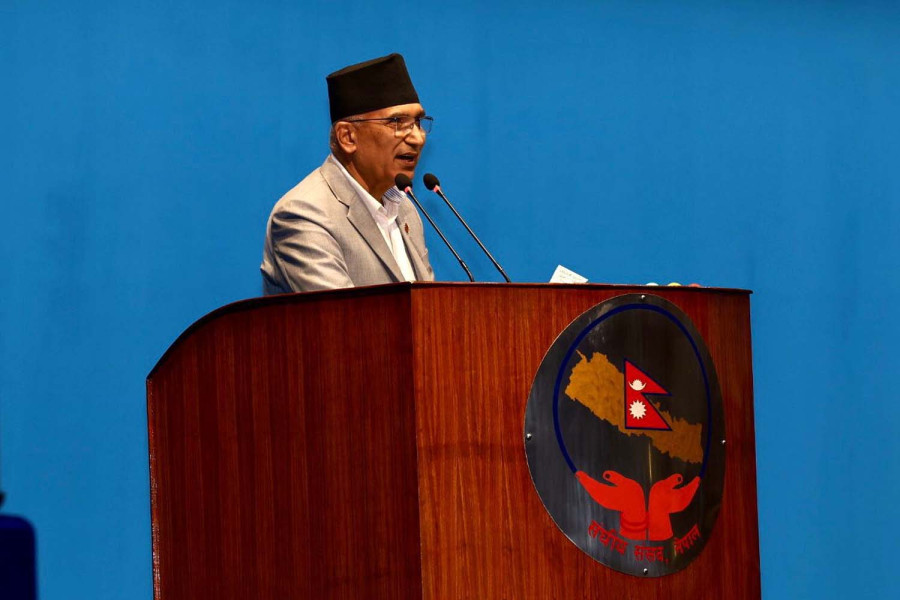Money
Budget trimmed by 9 percent, citing low spending capacity
The revised estimate is Rs1.69 trillion. Only 35.89 percent, or Rs667.6 billion, spent in the first six months.
Sangam Prasain
The government has reduced the annual budget by 9 percent, acknowledging its inability to fully use the allocated funds. It did so through a mid-term budget review presented on Thursday.
Initially, the budget for the current fiscal year, ending mid-July 2025, was set at Rs1.86 trillion.
Finance Minister Bishnu Prasad Paudel announced a mid-term review in Parliament on Thursday, saying that the revised estimate is now Rs1.69 trillion, or 90.99 percent of the original allocation.
In the first six months of the fiscal year, 35.89 percent (Rs667.6 billion) of the budget has been spent, though it represents a 17.66 percent increase from the same period last year.
The revised expenditure estimates include Rs1.02 trillion for recurrent expenses, Rs299.5 billion for capital expenditure and Rs363.93 billion for financial management.
By the fiscal year’s end, the government expects to finance Rs1.47 trillion from domestic revenue and internal borrowing, Rs36.62 billion from foreign grants, and Rs180.83 billion from foreign loans.
In the review period, Rs34.89 billion was transferred to provincial governments and Rs150.26 billion to local governments. Around 36.17 percent of the provincial budget and 48.10 percent of the local government budget were transferred, accounting for a total grant transfer of 45.28 percent.
Economic analyst Nara Bahadur Thapa said Nepal’s low budget spending could have wide-ranging implications across various sectors, especially as the country aspires to graduate from the least developed country status by 2026.
“The Rs1.86 trillion budget is not big given our ambition to graduate. However, reduced government spending means less investment in infrastructure, public services, and development projects.
This can lead to lower economic growth and a decline in job creation.”
“For years, budgets have been announced without assessing the implementation capacity, only to be reviewed halfway through. This pattern not only disappoints people who have high expectations from the government, but also discourages private investment,” Thapa said.
Essential services like health, education, and social welfare programmes may suffer from underfunding.
The government has decided not to create new organisational structures or staffing positions in its offices, regulatory bodies, or public institutions to control spending.
Paudel told lawmakers that a quarter of the remaining recurrent budget would be frozen, except for mandatory expenses.
Infrastructure projects will only proceed once land acquisition, compensation distribution, and forest clearance approvals are completed.
He said national pride projects will get priority funding to prevent shortages, while foreign aid-funded projects will be closely monitored to ensure compliance and better coordination.
Government entities cannot create additional financial liabilities without prior approval from the finance ministry. Multi-year project approvals will be honoured, but current fiscal obligations will not carry over to the next fiscal year.
Foreign aid will be directed to strategic, high-impact projects, and all development assistance will be incorporated into the national budget system to enhance transparency.
Paudel attributed the low spending to poor budget planning. Funds are often allocated to projects that lack essential preparations, such as securing forest land usage, completing land acquisition and compensation distribution, and conducting damage assessments.
Additionally, budget proposals frequently lack a well-defined construction modality, total cost estimates, detailed project reports, and objective economic, social, financial, technical, and geological evaluations.
“This results in poor project execution, with some well-funded projects getting insufficient budgets while new projects are introduced within limited fiscal space. The growing number of projects makes financial management challenging, leading to delayed payments and incomplete projects,” said Paudel.
He highlighted inefficiencies due to poor coordination between federal, provincial, and local governments.
Overlapping social security, grant programmes, and redundant development projects reduce budget efficiency and hinder equitable resource distribution.
Additional hurdles include delays in filling key project leadership positions, frequent staff transfers, shortages of construction materials, ineffective labour management, and failure to update or enact timely laws and guidelines.
“As a result, even by mid-year, the foundation for spending remains unclear,” Paudel said.




 8.12°C Kathmandu
8.12°C Kathmandu















